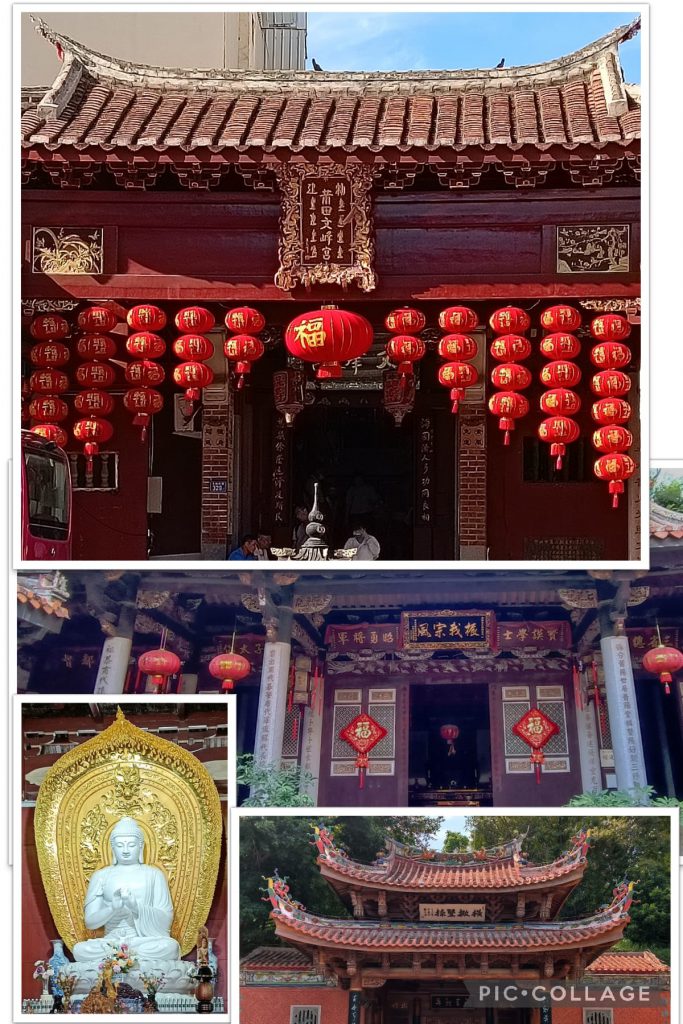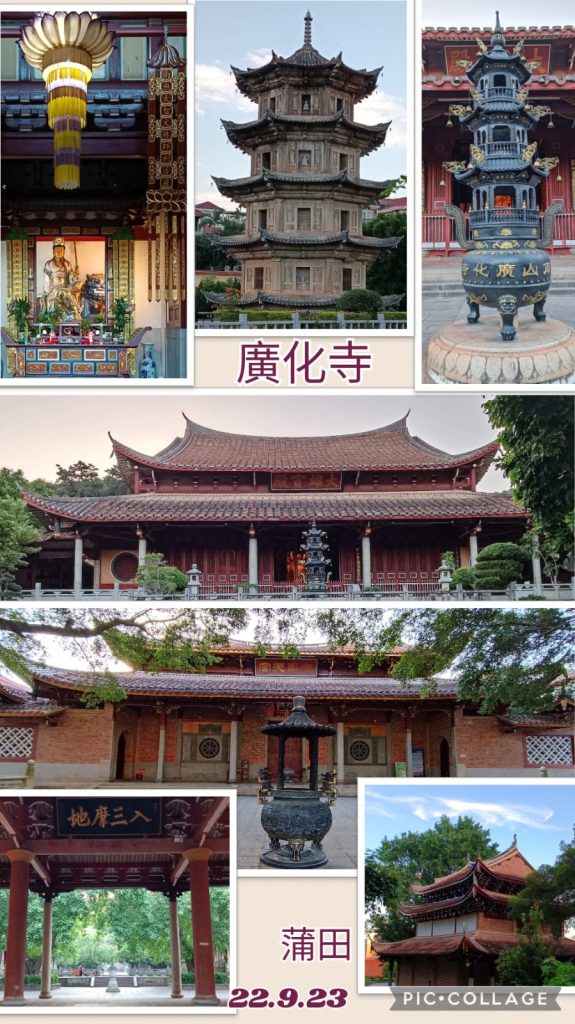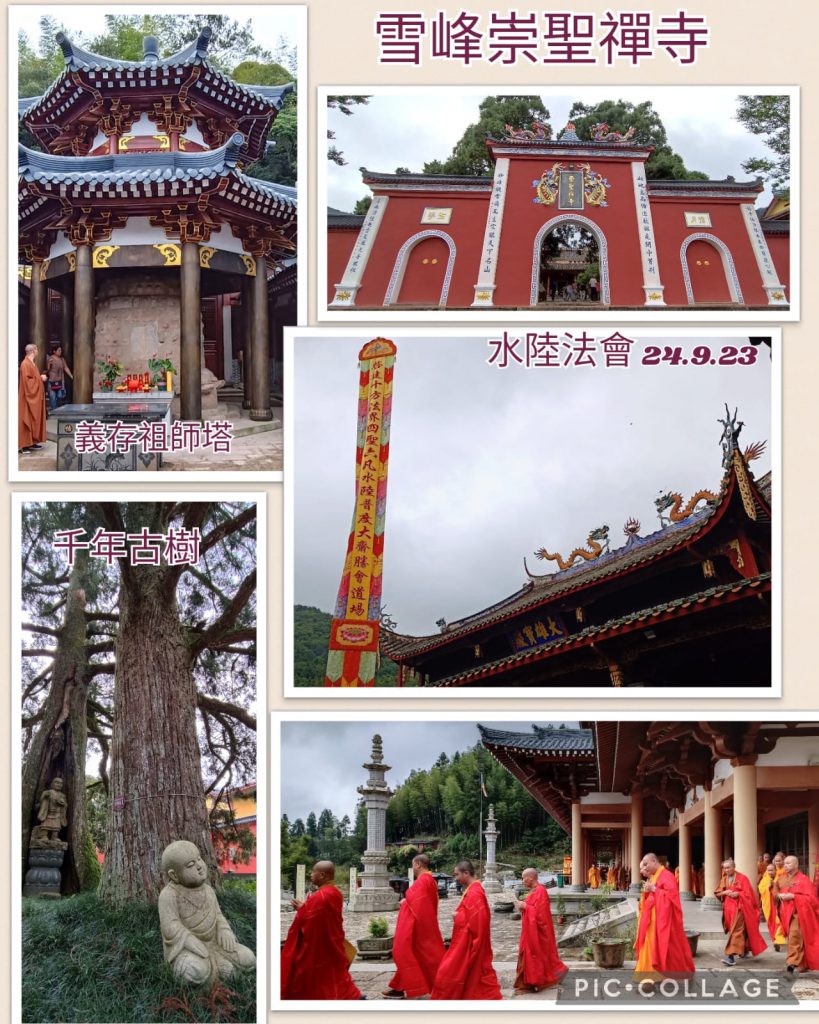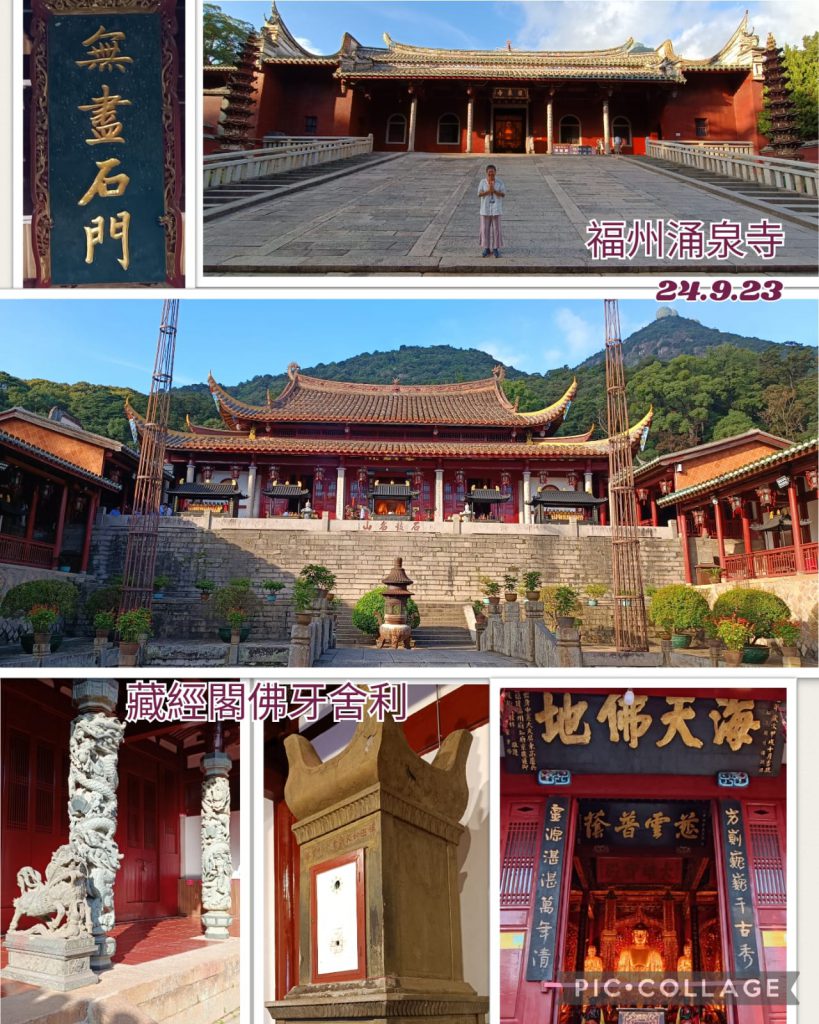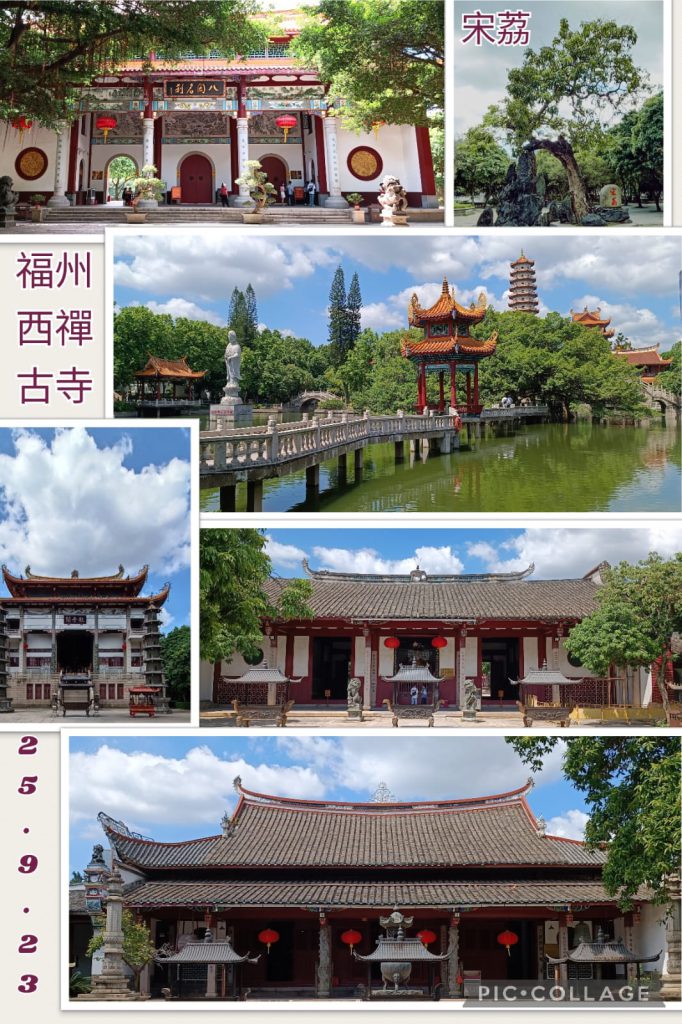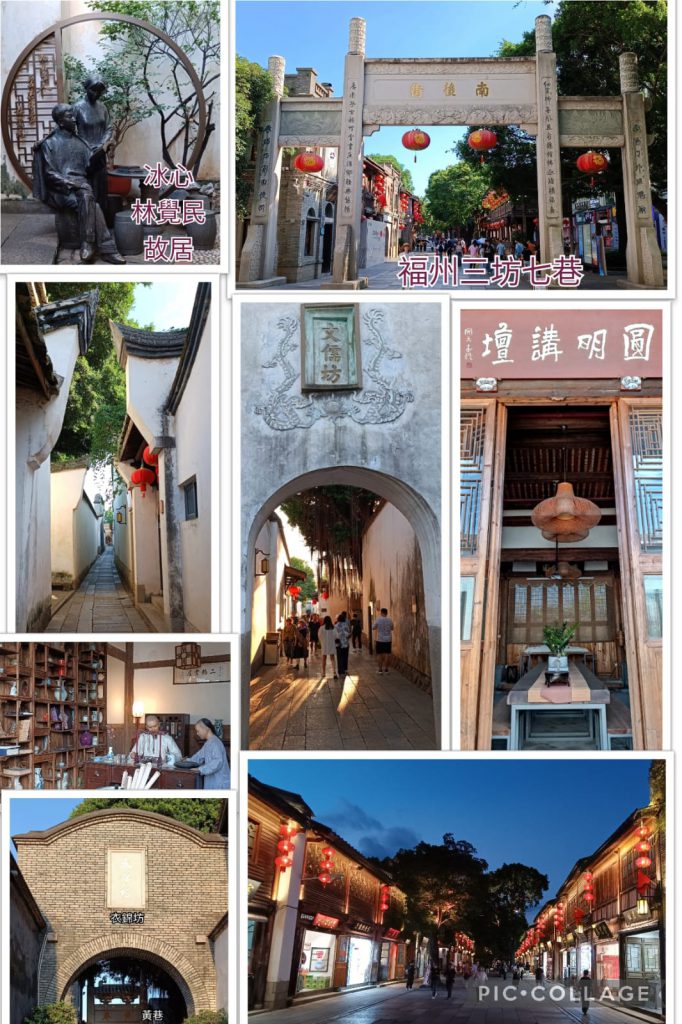I joined a 5-day pilgrimage trip to Fujian 福建 (September 21-25) organised by the Buddhist Compassion Organisation and stayed behind in the Fuzhou for two more days a few days. It is a nice discovery tour : while the basic structures and layout of all Chinese temples have similar features, all the nine temples visited have over a thousand years of history with the oldest one dating back to the end of the sixth century.
Fujian
Fujian with a population of 37 million is a coastal hilly province of which 80% of its area is mountain. It has long been an outward-looking province involved in maritime trade. It is the homeland for most Taiwanese and overseas Chinese, especially in Southeast Asia. The major cities include Xiamen 廈門 (a port town and former foreign concession), Quanzhou泉洲, an old port city with a Maritime Museum (Marco Polo considered it as“one of the two greatest havens in the world for commerce”, and Fuzhou 福洲 (the provincial capital with an old-town district and a small maritime museum).
Rich in natural and cultural heritage, Fujian has five world heritage sites (Mount Wuji, Fujian Tulou, Kulangsu in Xiamen, China Danxia in Taining and Quanzhou: the Emporium of the world in Song (960-1279) -Yuan (1368-1644) China. It also has an amazing variety of religious structures belonging to Buddhism, Daoism, Christianity and Islam. The main temple of the sea Goddess Mazu 馬祖is in Putian蒲田. The first Catholic missionaries, Franciscan monks reached China via Quanzhou in 1313.
September 21: Quanzhou
The group of 36 departed by high-speed train at West Kowloon around 9am and changed in Shenzhen 深圳. Upon arrival in Quanzhou after 2 pm, we lost no time and visited Kaiyuan Temple 開元寺 built in 685 or 686 during the Tang dynasty (618-907). It was inscribed on the world heritage list along with other sites in Quanzhou. The central figures of veneration enshrined in the Mahavira Hall 大雄寶殿are the five Tathāgathas from Chinese esoteric Buddhism. Some columns have fragments with Lord Vishu in the South Indian style from a Vishnu temple built in 1283 by a merchant community from Tamil in Quanzhou. It is the largest Buddhist temple in the province.
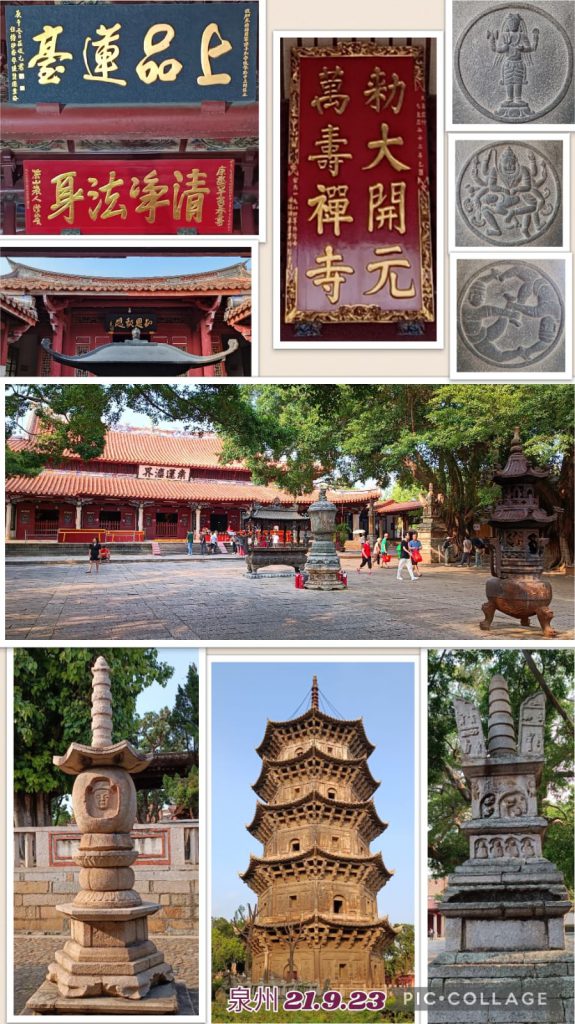
There is a museum/memorial hall on Master Hong Yi (1880-1942) 弘一大師 who was a master painter, musician, dramatist, calligrapher, seal cutter, poet before becoming a Buddhist monk in 1916. He spent his last fourteen years in Quanzhou and his life, photos, works etc are displayed in the hall.
After the temple, we strolled in the old town admiring the blend of architecture of the old buildings with beautiful mosaics and western-styled balconies. There are also ancient boundary markers of the old town which was once the largest custom house was located for collection of tax on merchandised goods.
September 22 Quanzhou & Putian
We began the day at Chengtain Temple承天寺 (957-958). Originally known as the Nanzhen Temple南禪寺, it changed to its present name in 1007 and was rebuilt in 1691 during the Qing dynasty (1636-1912). Serious damages were done during the cultural revolution (1966-1976). A Buddhist monk from Singapore vowed to renovate the temple in 1983 and works were completed in 1990.
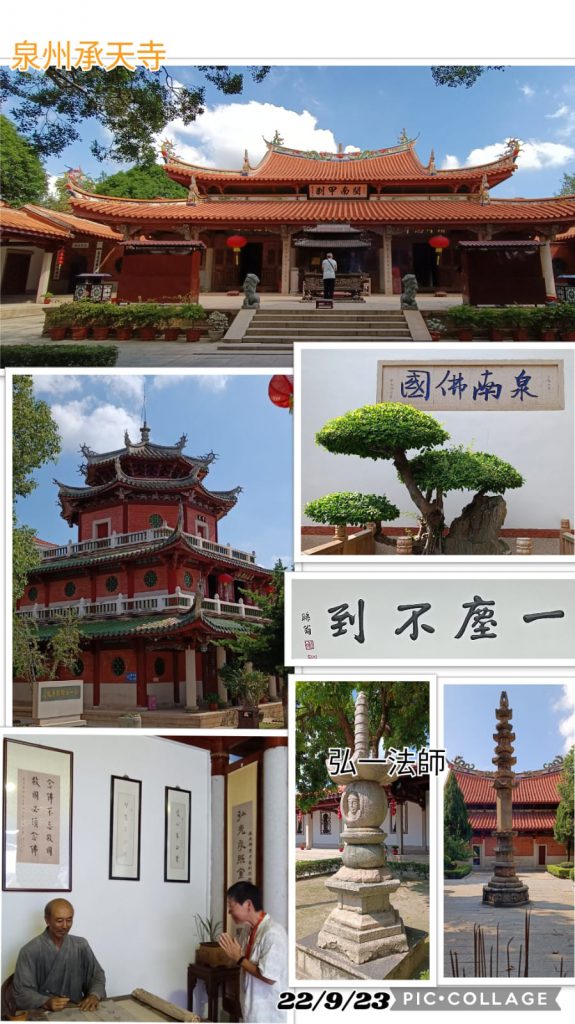
While the layout and structures of the halls and buildings are like most of Chinese Buddhist temples, there are a few interesting features. At the southwest corner of the temple is a site of a mint (942-944) where important archaeological finds were discovered in 2002. There is a stone column of sutra inscription with sculptures (1102-1106) with 13 levels relocated here. During his 14 years in Quanzhou, Master Hong Yi stayed most frequently in the Chengtain Temple. Before leaving the temple, I visited the living quarter where the Master spent his last days and passed away on 13 October 1943. He was cremated in this temple.
Before lunch, we had a stop at a tourist attraction where many traditional buildings of Fujian were preserved and relocated here. The most notable grand buildings are the Zhuang’s Clan Temple, Open-air Stage (opera/performance) and Cai’s Clan Temple. As we only had an hour, I only had a quick tour.
After lunch, we visited the Mazu Temple 文峰宮in Putian opposite is a small temple called Fengshan Temple鳳山寺. I discovered a beautiful and serene white jade Buddha in this small and derelict temple.
The last stop was the Nan Shan Guang Hua Si廣化寺 located at the foot of Mount Phoenix. The monastery has a long and tumultuous history. Built in 588 and named Jianxian Monastery 金仙庵, it is one of the most influential Chinese temples in China and one of the most scenic visitor attractions in Fujian spreading over an area of more than32,000m. In 771, Emperor Ruizong of Tang named it Lingyan Temple靈岩寺 and was renamed Guanghua Temple during the reign of Emperor Taizong of Song (976-997). Together with Gushan Spring Temple 鼓山涌泉寺, Kaiyuan Temple, and Xiamen’s Nanputo Temple南普陀寺, they were known as the four great Buddhist monasteries or Conglin 林of Fujian Province. During the Song and Ming dynasties, it was destroyed and rebuilt. Qing Kangxi Emperor carried out a comprehensive building programme in 1692 and merged it with the nearby Fahai Temple 法海寺. But by 1886, only the Avalokitesvara Pavillion with two resident monks remained in the monastery. A rebuilding programme began since 1890 and monks of the monastery spread Chinese Buddhism to Malaysia and Indonesia. temple. It continued to be restored and rebuilt by its abbots. During the cultural revolution, it was used as a factory and barrack. After the revolution, Abbot Master Yuanzhou 圓拙法師 (1979-1986) funded the establishment of the new Fujian Buddhism Academy 福建彿學院on the site in 1983.
I find this monastery built on the hill slope tranquil, spiritual and atmospheric. The principal features include a Memorial Arch, Pool of Rebirth, tall Mountain Gate, Hall of four Heavenly Kings, Mahavira Hall, Buddhist Hall, Jialan Palace, Tripiţaka Hall, Hall of Kritigarbha and a 30.6m-high stone pagoda (1165) from the Song dynasty.
September 23: Fuzhou
In the morning, we visited the Wanfu Temple 萬福寺 of Chan’s Linji sect 臨濟宗. 黃檗山First established in 789 by Zhenggan 正于, a pupil of Huineng 惠能 (638-713), the Sixth Patriarch of Chan School, it was destroyed and rebuilt several times. The temple came to fame as its 33rd abbot Master Yinyuan 隱元travelled to Japan on invitation in 1654 with his disciple Muyan and a delegation. Together they founded the Japanese Ōbaku school of Zen 黃檗宗. The head temple of the Ōbaku school in Uji City is named after this temple. In the 80s the temple was badly destroyed by flood. In 1989, the temple was reconstructed/renovated with the assistance of Sino-Japanese Buddhist communities.
Located at the foothill of the Huangbo Mountain黃檗山and surrounded by hills, this newly built temple with a long history looks grand with Japanese flavour. I find the natural setting and the long walk to the mountain gate next to the pool of rebirth enchanting. (After the 88-temple pilgrimage in Shikoku in end November 2023, I visited the Obaku-san Manpuku-ji Wanfu Temple lined with great Chinese-style temple buildings with Chinese flavour).
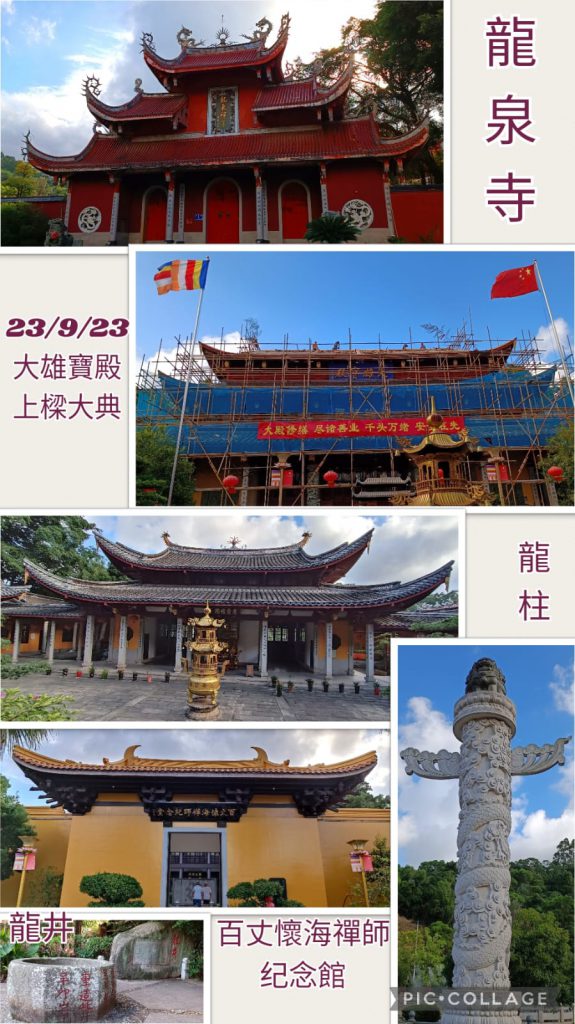
In the afternoon, we visited the Dragon Springs Temple 龍泉寺. Originally built in 554 and known as the West Hill Temple西山寺, it was the temple where Master Baizhang Huaihai 百丈懷海禪師 (749 – 814 ) became a monk. Emperor Yizong 唐懿宗renamed it Dragon Springs Temple during his reign (860-873). This famed temple had been expanded and renovated in the Song dynasty. But by the mid-fifteenth century during the Ming dynasty, it was derelict and badly destroyed. Renovated in the sixteenth century, it regained its former glory in the eighteenth century. It was again badly damaged during the cultural revolution. Thanks to the zeal and efforts of a few leading monks, the temple has been renovated with principle features restored or rebuilt. In 1998, the Dragon Spring Buddhist Academy began to take in monastic students.
September 24: Fuzhou
We set off early and had a long and beautiful drive to the Snow Peak 雪峰to visit the famous Chongshengsi 崇聖禪寺. In 870, Master Yicun義存 (822-908) established a temple which was called 枯木庵. At its peak, the temple endowed with royal patronage and generous donations, had over 1500 monks. Two disciples of Master Yicun established two sects of the Chan school namely the Cloud Gate 雲門 and Dharma Eye法眼. As a result, Chonhshengsi is also regarded as the headquarters of these two sects. During the Song dynasty, it was renamed Chongshengsi in 978. Highly regarded as the first of the ten old temples during the Song dynasty and one of the five conglin in the Qing dynasty, it has long been a pilgrimage site. However, towards end of the Qing dynasty, it had badly damaged as a result of wars. Since late 1970s, the temple with support from Buddhist communities locally and overseas, has been restored and expanded.
Located at the Snow Peak at an altitude of 870m, this expansive atmospheric temple now has an old and a new wing with sacred fragment of a Buddha tooth, relics of a couple of trees over 1000 years old, Master Yicun relics, pagodas of former abbots etc. As it was the last day of the important 7-day Water and Land Ritual, chanting could be heard with devote Buddhists prostrating in the hall. It was atmospheric. We also had lunch at the temple.
After lunch, we visited the Yongquan Temple 涌泉寺 located on Gushan Mountain. First built in 783 during the Tang dynasty and was called the Huayan Temple, it had gone through many changes and repairs. It was changed to Yongquan Chan Temple in the tenth ceentury because a spring flowed through its Four Heavenly Kings Hall. It was renamed Yongquan Temple in 1407 during the the Yongle era. Most of the structures in the temple were repaired and built around 1522-1566 during the Ming dynasty.
Today, the temple built along the up and down of the mountain has over 25 rooms and halls maintaining the architectural style of the Jiajing period (1522-1566). The treasures of the temple includes a bronze bell cast in the 18th century with the 6372 words of the Diamond Sutra carved on the outside, and over ten sets of Avatamsaka Sutra printed in the Ming Dynasty (1368-1644) preserved in the temple.
September 25 & 26: Fuzhou
When the group departed after breakfast, I moved to stay in a hotel near the high-speed train station. Using taxi and the MTR, I had two days exploring Fuzhou visiting only three attractions. The first place I went was the Xichan Temple 西禪寺 with many famous monks since the Tang dynasty. Built in 867, the temple in its heydays had over 3000 monks. Interesting features include two laichee trees from the Song dynasty and five pagodas (one from the Tang dynasty and two from the Qing dynasty). Overseas Chinese have funded its restoration and renovation in the 20th century. Sadly, it was heavily damaged during the cultural revolution. It was only after 1982 when the temple was reopened and restored with overseas Chinese donation.
In the afternoon, I walked aimlessly in the Sanfang Qixiang (Three Lanes and Seven Alleys), a historic and cultural photogenic area with many preserved buildings and small museums of interest. Close by is an area with canals lined with eateries and tea houses which reminds me of Lijiang in Yunnan.
On the second day, I spent the morning in the Fujian Musuem and revisited the Sanfang Qixiang in the afternoon. I went into all the old houses that were open to visitors and a newly opened hotel that only serves vegetarian meals. Very interesting. I spoke to a lady who runs boutique in a restored house selling expensive costume of her own label. I also visited a few museums in the area. With a hip problem, I was too tired to walk up to a hill top nearby for a panoramic views. I had a nice dinner by the canal.
On September 27, I took a direct train from Fuzhou to Hong Kong which took about four hours. I was back in Hong Kong after 2 pm.
Remarks
While I have been to Mount Wuji, Fujian Tulou and Kulangsu in Xiamen on my first two trips to Fujian, it is my first time to visit temples. With the Buddhist studies in the past three years and being a Buddhist, I appreciate the chance to visit these old temples with long history. The mountainous setting of most of these temples is enchanting: I realise what congli means and the spiritual, religious and arduous life of the monastics. It is sad to see the rise and fall of these temples in the last 1500 years. I am moved to see the contributions of overseas Chinese, both monastics and laymen to the renovation and revival of these temples. It is inspiring to see the relics of renowned venerable such as Master Yicun, Baizhang Huaihai, Yinyuan and Hong Yi. There are so much to see in Fujian and I shall certainly return one day.


